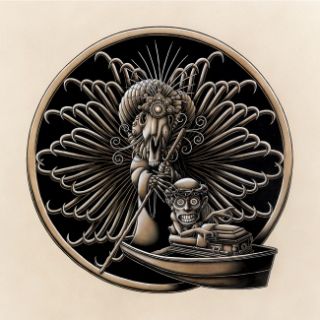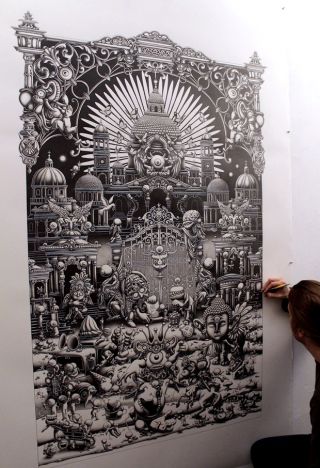Career
Life and Death in Black and White
An artist struggles with spiritual issues in his surreal drawings.
Posted September 26, 2013

Used with permission of Joe Fenton/Gallery House
Joe Fenton is a London-based artist who produces his large drawings using graphite, ink, and acrylic on paper. Influenced by the early Surrealists, his drawings are intriguingly grotesque, amazingly detailed, and filled with figures that look none too happy.
To quote the folks at his gallery (who know far better than I do how to describe Fenton's unusual art): "Joe uses motifs that suggest Eastern philosophy and Middle Eastern architecture whilst maintaining a feel for European Baroque and Rococo with complex frame ornamentation and plant-like details."
An interview was conducted with Joe Fenton by GalleryHouse, and I've edited it here:
Q&A with Joe Fenton, artist:
Q: What compelled you to start making art? Was there a pivotal moment?
Like many children I was naturally creative as a child, in my school reports my art teachers were always impressed with my ability to stay focused unsupervised. So if there was a pivotal moment I think it was while at boarding school around the age of 8 or 9, as that was when I first made the connection that being an artist was something I could describe myself as.
I continued to enjoy drawing up until the age of 12 or so and then I lost interest in it completely. Adolescence was not much fun. I found school to be difficult as I struggled with authority and structure, and as a result I was eventually thrown out. It wasn't until I was 26 I decided to go back to education and pursue my art again after getting side-tracked by the world of drugs and alcohol.
Q: What is your biggest challenge personally as it pertains to doing your work?
Preventing isolation has always been the key challenge for me. I am a bit of a hermit and tend to isolate so I have a great excuse as an artist with having to lock myself away in my studio every day for hours on end. The problem with this has always been to find a balance with my studio time and doing other things.
The dilemma lies with the fact that it takes many studio hours to create my work and there is no real way around it. I also feel in some part this struggle feeds into my creative process. I would hate to come across as a cliche but there is some truth in the fact that, historically, from pain and suffering some of the most amazing art has been created.
Q: What is the significance of drawing in black and white? Have you ever worked in color or thought about adding it in the future?
I find there is something truly honest about a black-and-white image. I love its simplicity. Although, as I find the need to evolve artistically, I am starting to think about introducing color into some of my future designs. I am beginning to feel too comfortable working in black and white only, and this is not a good place for an artist to be in. I don't want to feel that I am repeating similar work over and over again. I also don't want my decision to not use color to come from a place of fear. I want to feel comfortable using color and black and white equally. It looks like I have set myself a challenge.
Joe Fenton/Gallery House, used w. permission

Joe Fenton/Gallery House, used w. permission
Q: Can you go into some detail explaining the figures in your pieces and their relationships to one another?
I first discovered the works of some of the early surrealists such as Hieronymus Bosch and Pieter Bruegel when I was at art school. The Seven Deadly Sins are prominent in much of their work. I love the way they used such expansive landscapes filled with so many details to present us with the depiction of man’s folly along with the consequences of their actions. Their art was created to teach specific moral and spiritual truths. You will see this subject matter occurring throughout most of my work.
Another theme which recurs again and again, is that of death and the fear of death. I don't know if by creating work that deals with this subject matter I am in some way trying to embrace my own mortality with the knowledge that you ultimately need to do this to truly be able to embrace life. I seem to jump from wanting to believe in something larger than myself to believing in nothing at all. This I find to be a dark place to exist in. This inner conflict reflects in the characters I create.
So you will notice gods and demons along with many other ambiguous figures that are gangly, writhing, and cramped, all fighting for a place at the throne in my work. You are never quite sure who has the ultimate authority.
It seems that I will always return to the same place: that of needing to find a spiritual solution to my condition. What energy I feed into life's current is what I will receive in return. My characters like myself are on this journey of contemplation and discovery.
Q: Explain your process—how do you go about starting a piece and then deciding when it’s finished?
I generally start off with a vague idea and then begin playing with shapes and designs. It’s a bit like a jigsaw puzzle, moving the pieces around until they all fit. What ultimately leads each design through its process is the story I'm trying to tell mixed with what works aesthetically. Each design grows organically. I never have complete knowledge of where my initial idea will end up. Sometimes when I am beginning a project it can take me a week or two before I have something that ignites me, and it's not a good place to be when this happens. There are a few stages of laborious tracing and re-tracing before I can start work on the final piece.
Q: What would you like to be remembered for?
I would like to be remembered for leaving artwork behind that touches people in some way.
- For more about Joe and his art, see his website.
- Contact Gallery House at belinda@galleryhouse.ca.
- All images copyright Joe Fenton and Gallery House.


